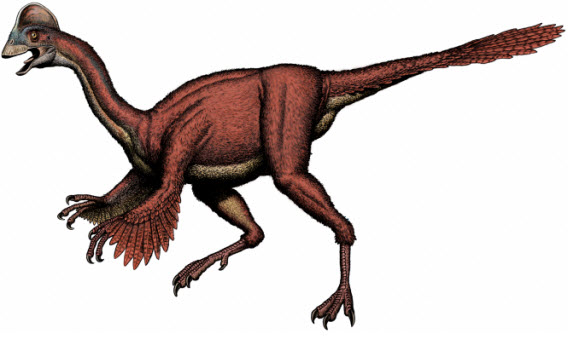Anzu Wyliei: The Chicken From Hell Oviraptorosaur
Posted on March 19, 2014

Paleontologists have announced the discovery of a bizarre, bird-like dinosaur named Anzu wyliei. Three fossil skeletons of the dinosaur jokingly nicknamed "Chicken from Hell" were discovered in the 66 million-year-old rocks of the Hell Creek Formation in North and South Dakota.
Anzu was about 11 feet long and five feet tall at the hip. Scientists say members of the new oviraptorosaurian dinosaur species would have partly resembled gigantic flightless birds. Anzu had a tall, rounded crest on its head. It also had large, sharp claws and a robust tail. The Anzu name comes from the bird-like demon in Sumerian and Akkadian mythology.
The Anzu study was led by Dr. Matthew Lamanna of Carnegie Museum of Natural History in Pittsburgh. Dr. Lamanna's collaborators include Dr. Hans-Dieter Sues and Dr. Tyler Lyson of the Smithsonian Institution's National Museum of Natural History in Washington, DC, and Dr. Emma Schachner of the University of Utah in Salt Lake City. The image below is of a mounted replica skeleton of Anzu wyliei on display in the Dinosaurs in Their Time exhibition at Carnegie Museum of Natural History, Pittsburgh, Pa., USA.
Dr. Lamanna says in the announcement, "Anzu is far and away the most complete caenagnathid that has ever been discovered. After nearly a century of searching, we paleontologists finally have the fossils to show what these creatures looked like from virtually head to toe. And in almost every way, they're even weirder than we imagined. We jokingly call this thing the 'Chicken from Hell,' and I think that's pretty appropriate. So we named it after Anzu, a bird-like demon in ancient mythology."
Dr. Sues says in a separate statement, "For almost a hundred years, the presence of oviraptosaurs in North America was only known from a few bits of skeleton, and the details of their appearance and biology remained a mystery. With the discovery of A. wyliei, we finally have the fossil evidence to show what this species looked like and how it is related to other dinosaurs."
A research paper about Aznu was published here in PLoS One.
Update: Here's a Dinosaur Spotlight on Anzu Wyliei from the Carnegie Museum of Natural History.
Image: Courtesy Bob Walters
